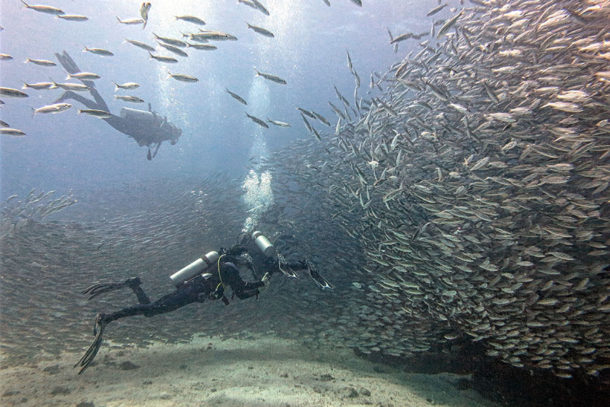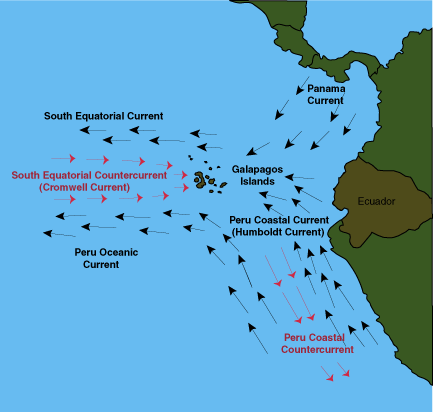At Academy Bay Diving, we specialize in organizing unforgettable Diving Trips in the Galapagos and tours that allow guests to Discover the Wildlife of the Galapagos. This extends to our daily Galapagos Land Tours too. But what is it that makes the waters surrounding the Galapagos Islands so unique? What climatic qualities make the Galapagos an ideal home for many diverse species?
The Galapagos Islands owe their astounding biodiversity and rich marine life to the combination of the converging of five major ocean currents and the equatorial surface weather. These conditions have perfectly harmonized to give an array of marvelous flora and fauna the ability to flourish here. And this kaleidoscopic biodiversity has been exciting visitors’ imaginations since Charles Darwin first came to the islands in 1835.

The World’s Most Diverse Marine Ecosystem
The Humboldt current, named after the European explorer Alexander von Humboldt, sweeps north up the western coast of South America, carrying cold, nutrient-rich water from Antarctica.
Traveling along the shores of Chile and Peru, it creates the world’s most productive marine ecosystem in the process. The Humboldt Current has been designated a Class I ecosystem for its highly productive biodiversity. The nutrient-dense waters and ideal temperatures of the Humboldt Current mean it’s a perfect habitat for phytoplankton to thrive; the large numbers of these phytoplankton draw populations of larger animals into the waters.
At the equator, the Humboldt turns west and joins the South Equatorial Current before heading straight towards the Galapagos. The South Equatorial Current is driven directly by trade winds blowing from East to West.
The Panama Current flows down from Central America and is not as rich in nutrients as the Humboldt. Still, it makes for warm diving with better visibility from December to May.
The wind-driven North Equatorial Countercurrent that runs west to east cuts through the middle of the two westbound currents and directs south down the coast of Peru and Chile.
The Cromwell Current and Galapagos Penguins
The final and perhaps most crucial current is the Cromwell Current (Pacific Equatorial Undercurrent), which flows about 300 feet from west to east along the equator. When it hits Galapagos, an upwelling brings more cool, nutrient-rich waters.
The Cromwell Current is home to a large number of fish, and this food source is of particular importance to one of the most iconic animals of the Galapagos Islands: the Galapagos penguin. The only penguin found north of the equator. The Galapagos penguin has several evolutionary adaptations to cope with the sporadic nature of the Cromwell Current.
You can browse our Multi-Day Isabela Tours and One-Day Isabela Island Tours if you want to observe Galapagos penguins in their natural habitat.

Join us and learn more about the Galapagos Islands by reading the following Academy Bay Diving blogs: Where are the Galapagos Islands?, Breathtaking Galapagos Island Dive Sites, and What is the Best Way to Visit the Galapagos Islands?.
If you’re planning your dream trip to the Galapagos Islands, please browse our range of Galapagos Islands Tour Packages and daily Galapagos Land Tours.
Have any questions about our tours or services? Please get in touch.






